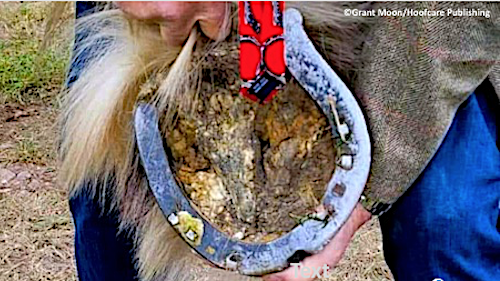Sometimes a great photo just jumps up out of the Internet and begs to be featured on the
Hoof Blog. Of all the millions of photos in the world, why do these very special ones find their ways here? I don't know, but I'm glad they do.
You're looking at a Clydesdale, the great national horse of Scotland. Each year the famed Royal Highland Show hosts an equally famous shoeing competition for farriers. Shoeing these horses is a time-honored tradition, and there exist minute variances in the way they are shod in these competitions that only a keen judge's eye can discern.
At the end of the competition, the horses' feet might all look more or less the same to the casual observer, but the judge knows better. And even within the strict Scottish tradition, there is room for a judge to have individual prejudices and preferences for details in the work that will often be the only dividing line between highly skilled executions of one of the most difficult shoeing assignments on earth.
After this photo was first published, the photogenic lads in the background were identified as former apprentices, now "qualified" (graduates who have earned their diplomas, and stayed on as employees) farriers, of two of today's leading British farriers, business partners
Jim and Allan Ferrie in Ayrshire, Scotland.
Jim wrote when he saw the photo on the
Hoofcare & Lameness Facebook Page: "
(That's) Graham McBurney on left and Jackie Campbell on right. It was their first time competing as qualified Farriers at the Royal Highland. Jackie won the apprentice championship last year.
"Although they did not win, both got the hind toe bars welded on and finished on time with very respectable jobs."
 |
| Royal Highland Show Archives Copyright-Protected Image |
Sixty years ago, the Royal Highland Show farriers worked outside. Here you see the late Edward Martin in his first Royal Highland shoeing competition. And right behind him, at the next anvil, is the grandfather of Allan and Jim Ferrie. As you can see, not that much has changed, although Edward is sadly missed since his death. I hope that the Ferries will have some connection to the Royal Highland Show for as long as it continues, which will likely be as long as there's a Scotland.
This photograph has a great story to tell.
Click here to reveal what this day meant in the life of a very young Edward Martin.
You won't see adhesives and casting tape or aluminum and plastic. You will see hammers and fullers and pritchels at the anvil, rasp and nippers and a knife at the horse. And not much else. You have to do it with the same tools they've always used.
Another reason to love Scotland: tartan plaid ribbons. In Scotland, the red ribbon is first prize. (Photo courtesy of the Royal Highland Show)















Something about this photo just grabs me. It's another of those, "Huh!" sorts of photos. A photographer frames something we see often in a way that makes it interesting and visually compelling. And makes it look pretty dangerous!
Photographer Tim Dawson had a wonderful time at the New Zealand Farriers Association's North Island Dairy Flat Forging and Heavy Horse Competition in Auckland on July 23-24. While I try to figure out which farrier this is, I will let you enjoy the shot.
For the uninitiated who may have stumbled upon this image, you are looking at the age-old act of a hot horseshoe being pressed against the trimmed bottom of a Clydesdale's hoof. The farrier will hold it there firmly for a few seconds (no, it doesn't hurt the horse) while it gives off some acrid sulphurous smoke. Then he will pull it away and observe the hoof to see if the burn mark is uniform around the wall of the hoof. This will tell him if the shoe is level; without a level shoe, the nails won't be tight and if the nails aren't tight...well, you remember the old "All for want of a horseshoe nail" ditty.
This process is called "hot fitting" and it is done for all types of horses. It is even done for Thoroughbred racehorses, though they wear thin aluminum shoes that can't be heated and pressed. I don't think it has been scientifically proven, but it is widely believed that feet that have been hot fit hold together better because the horn tubules are somehow "sealed" by the heat and they keep out bacteria or there is some other beneficial effect that protects the hoof wall.
But nothing is quite as dramatic as hot fitting a Clydesdale.
The Clydesdale competition was won by Grant Nyhan, Marcel Veart-Smith and Deane Gebert.
Thanks to Tim Dawson for allowing this photo to be shown on the Hoof Blog today.